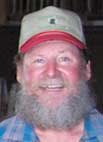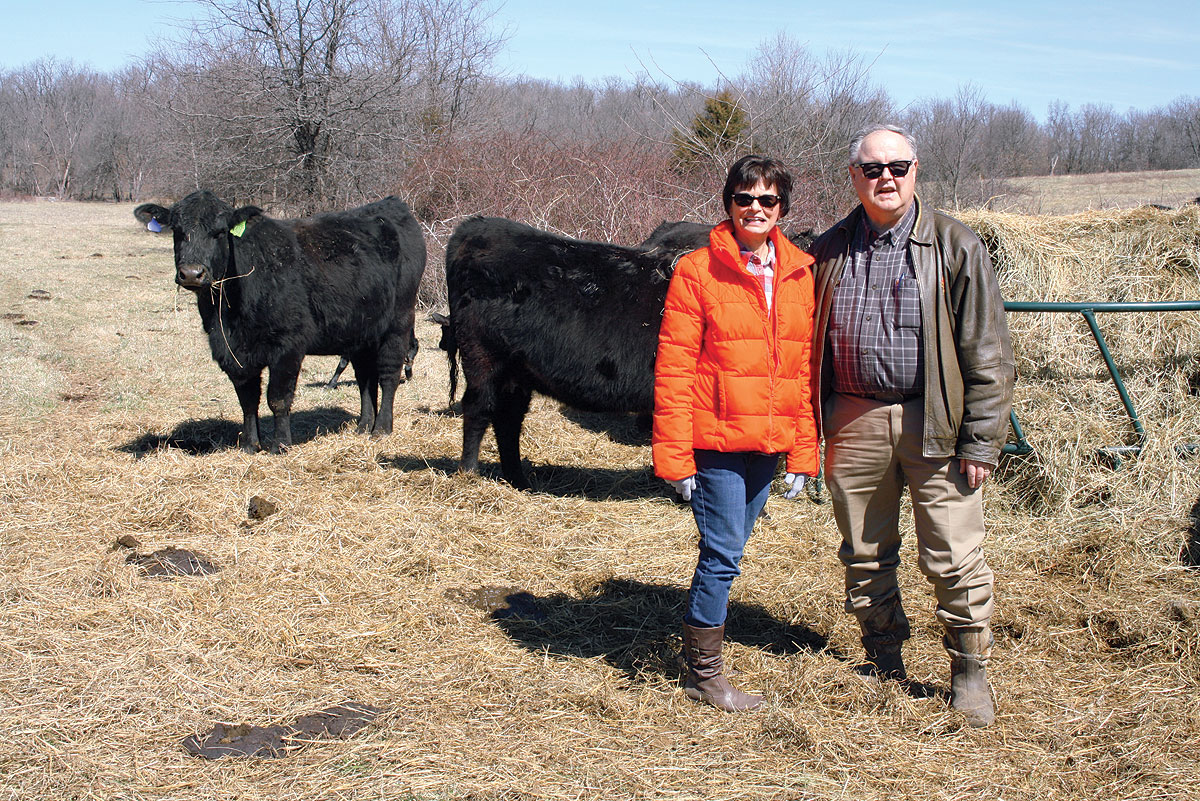
Building quality Shorthorn herd motivates Carl Buckingham
ROGERSVILLE, MO. – As a teen, Carl Buckingham showed a string of Shorthorn cattle.
“I showed back in the late 1970s, early 1980s,” Carl recalled. “Then life took over. I always helped people in agriculture, but there was a time I didn’t have any cattle for years.”
Eight or nine years ago, his grandson Kegan approached Carl about showing cattle, and the doting grandpa was all for it.
“Having a young person involved in agriculture and taking care of animals helps them with life skills like no other activity,” Carl said. “I was all for it because I truly think agriculture makes kids better.”
Carl let Kegan pick the breed of cattle he wanted to venture into.
“It was what he wanted, not what I wanted, and I’m not disappointed,” Carl said with a laugh. “He had seen some Shorthorns and decided that’s what he wanted to do. I was excited and scared to death because my folks weren’t interested when I showed, so I knew how much work goes into it. I don’t regret a bit of it; I like it.”
Kegan has found some success in the show ring, and today, the duo is still breeding registered Shorthorns.
“I am going to keep them until I can’t take care of them anymore,” Carl said. “If I could have, I would have run cattle my whole life. I enjoy messing with cattle more than I do anything else.”
Shorthorns have appealed to Carl since he was young because of their docility.
“I can walk out with every one of my cows and pet them, and they will walk right up to me. When Kegan started, that docility was huge for me,” Carl said. “Also, when you have a calf, you never know what it will look like. With Hereford, Angus, Charolais, and most any other breed, you know you will have a white, black, red, whatever calf. With Shorthorns, it’s a surprise every time.”
Carl said many breeds have incorporated other genetics and lost much of their breed characteristics over the years, but Shorthorn has remained steady.
“Everyone wants black cattle, but you can still tell a Shorthorn apart from other breeds,” Carl said, adding that Shorthorn cattle, in his experience, are growing.
Carl is selective about the genetics he has incorporated into his herd.
“Like everyone else, you want the best in the world, but my pocketbook does not justify that,” he said with a laugh. Carl wanted quality show genetics but to incorporate other traits, such as longevity.
“One of the best cows we had in the ring is one of the best cows in the pasture,” Carl said. “She drops a calf in less than 365 days every year, milks like a dairy cow, and that’s what I am looking for. I still want the eye appeal and the big box, and I want Kegan to win the banners and be competitive, but I need productive cows. I’m blessed with a solid foundation for my herd.”
The beginning herd was sourced from a fellow Shorthorn producer in Northwest Missouri, Alden Farms. HEifers were also brought in from Colorado and Minnesota.
Through selective breeding, the Buckinghams produced the grand and reserve bred and owned Shorthorns at the 2024 Ozark Empire Fair.
“I think our genetics are pretty good,” Carl said. “We have some excellent cows and are getting where we can be competitive for years to come. The breed is improving so much, and so is the competition, in the last seven or eight years. You have to have something pretty spectacular anymore to be competitive.”
Carl said his goal is to keep improving each generation of his herd, and he has primarily AI’ed his females, which has also allowed him tremendous genetic diversity.
“You can buy the best of the best and AI,” Carl said. “Other than embryo transfer, AI can improve your herd faster. You can’t afford to buy every bull that fits every cow, especially for a small operation. I can’t buy the bulls, but I can buy the semen.”
The Buckinghams were given an opportunity to incorporate a new sire this year.
“Scott Bass bought a Shorthorn bull from Wakaru Farms (located in Indiana) this year to run with his crossbred heifers, and he found out it was in the grand champion pen of three at the Oklahoma Cattle Congress,” Carl recalled. “He asked Kegan if he would show him, so we did, and I have been taking some cows to breed to him. It opens up a whole different door, and his EPDs are outstanding.
“It’s a complete outcross from anything we have bought and any bull we have used, so I will find out in June if that outcross worked.”
Since returning to registered Shorthorns, Carl said they have not focused on the production of bulls, but it is not out of the question.
“We had a bull that we were successful with, and he has gone on to a commercial herd, and they’re happy with him,” Carl said. “The difference between me and a lot of breeders is that the knife comes out early. Selling a subpar bull can hurt the breed quickly. I would love to raise an awesome bull that would improve the breed; I think it would be anyone’s dream to have a game-changing bull. When we have a bull, I watch him pretty close, but if it’s not going to improve the breed, they are good on the dinner plate.”
The decision to steer a bull depends on the calf and pedigree, with some castrated well after weaning. Steers are sold for beef or sold at the stockyards.
“I’m not making a living on my cattle, so I can do that,” Carl, who also owns a construction company, explained. “If I can break even, I’m all smiles. That might change in the future.”
He is just as selective when it comes to heifers.
“If she isn’t good enough for me to keep, I take her to the stockyards or the dinner table,” Carl said, adding that animals sold as feeders or for beef are supplemental income for the breeding program. “I don’t want to sell a subpar animal that doesn’t help the breed. If you sell something subpar, it just hurts and breed, and you, as the breeder, are hurting your name.”
Retained heifers are bred to calve at about 24 months.
“Getting that first calf on the ground is important. Then I want another 10 or 12 from her,” Carl said.
He added he is not always sold on easy-calving bulls because some of those calves fail to thrive, and half of the equation is the dam’s genetics. And Carl has faith in his cows’ ability to calve on her own.
Calving is done year-round in the Buckingham herd.
“They are pretty scattered,” Carl said. “A lot of that is because we show, and we don’t want four heifers in the same class. I haven’t decided what’s best for us yet, but I don’t like January or August calves; it’s too cold, too hot or too many flies. I will have several calves in June this year and some in July, but that’s just the way it worked out. Ideally, I like September/October calves. Once they are weaned, they get out on grass and do well.”
Carl’s nutrition program continues to evolve, and cows can’t stay on show feed their whole lives.
“I’m blessed with cows that can make it raising a calf on grass,” Carl said. “I think that’s important because the commercial producers don’t feed a lot, so you have to have cattle that will make it on grass. If you have to pour feed into a calf, it won’t do well. I don’t like my cattle as fat as the show world likes them, so I get penalized for that, but I don’t think tons of fat on a cow is a real-world application.
“I’m still working on my mineral program and keep adding more, and I think that is more important than feed, as long as you have reasonable hay and pasture. Our grass in the Ozarks isn’t the most nutritional, so you have to be careful.”
Carl admits he is a little overstocked on his available pasture, which is another reason he works to perfect his herd’s mineral program.
While the Buckingham Shorthorn program started with a new generation to focus on show cattle, Carl said he is looking at an additional path.
“The goal, even with show cattle, should be to improve commercial cattle,” he said. “The bottom line is that cows are here to eat. With the Shorthorn breed, if we can keep working to sell bulls to commercial herds to crossbreed and get better meat. Shorthorns have always done well with crossbreeding and are an outcross for many breeds.
“You have to grow show cattle that will make it to the farm. You can’t raise cattle just to win a ribbon. The goal is to raise good cattle with longevity, produces a calf every year, milks good, and is good to eat. Eye appeal is important for anyone who loves cattle, so you want to have that too.”
Eventually, Carl would like to expand to as many as 30 cows, but he will not sacrifice quality.
“I think you could do almost as well as some of the big boys with 100 head if you take care of things,” he said. “I enjoy cattle, so I want to be able to take care of them, and when I don’t want to do it, it’s time to get out of the cattle business.”







